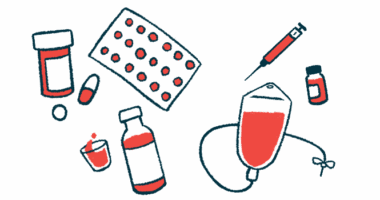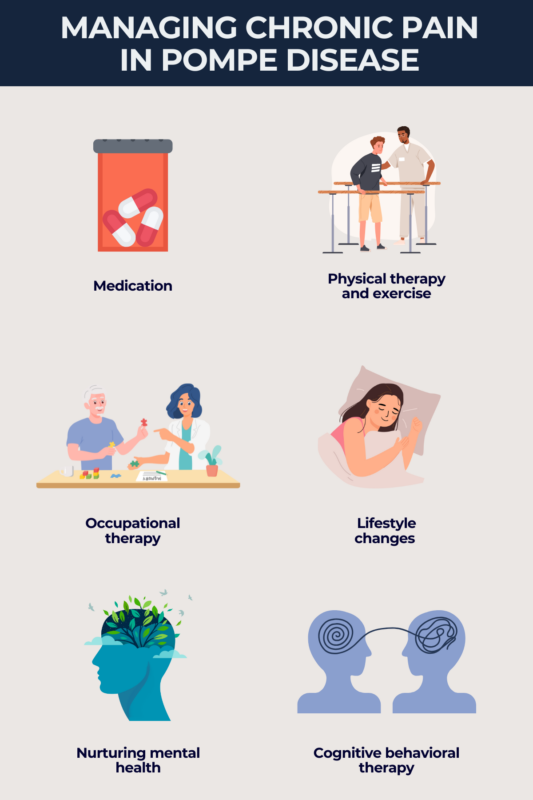
Managing chronic pain with Pompe disease
Last updated Nov. 8, 2024, by Lindsey Shapiro, PhD

Chronic pain is a common symptom of Pompe disease that can have a substantial impact on your quality of life. For this reason, long-term pain management is an important component of living with the rare neuromuscular disease.
In Pompe disease, a complex sugar molecule called glycogen toxically accumulates in the body’s tissues, especially muscle cells. It can cause symptoms such as muscle weakness and respiratory problems. Pompe-related pain can originate from various sources, including from damage related to glycogen accumulation in muscles, nerves, and other tissues.
Because every person experiences pain differently, managing it requires a personalized treatment plan. Keeping pain under control in the long-term is likely to involve a multidisciplinary approach that may include medications, physical therapy, mental health support, and other interventions.
How chronic pain impacts daily life
Pain from Pompe is common. One study reported that nearly half of surveyed adults with the rare disease said they’d experienced pain in the last 24 hours, compared with less than 30% of people without Pompe. In a smaller study, 88% of patients said they’d had pain in the last week.
It’s possible to have pain from Pompe years before being diagnosed. And that pain may be ongoing, either intermittently or constantly, throughout life. When you have pain for at least three months, it’s considered chronic.
Types of pain in Pompe
There are many ways that Pompe causes pain — and many different types of pain. This may include:
- Neuropathic pain from glycogen accumulation causes damage to the nerves throughout the body. It may feel like burning, tingling, or aching — abnormal sensations collectively known as paresthesias.
- Musculoskeletal pain caused by glycogen accumulation in muscle cells can lead to muscle tissue damage and inflammation. Muscle weakness can result in orthopedic problems such as scoliosis, an abnormal sideways curvature of the spine, which can cause postural issues and stiffening that drive back pain.
- Fatigue-related pain can occur as disease-related changes in Pompe lead to extreme fatigue, which in turn might make pain worse. Chronic fatigue and pain are commonly reported to coexist in people with Pompe.
Pain from Pompe disease is often chronic and widespread, commonly affecting areas such as the back, shoulders, and upper legs. The pain can range from mild to severe and vary in how it feels. In one study, Pompe patients most often described their pain as “exhausting.” Other descriptors included pulling/tearing, dull/pressing, pricking/drilling, and tender.
Over time, how the brain responds to pain may change, making it harder to deal with the symptom.
Daily life impact of pain
Chronic pain, especially when coupled with fatigue, can have a great impact on various aspects of your daily life with Pompe and may eventually affect your overall quality of life.
Most research on pain in Pompe has focused on adults with late-onset Pompe disease (LOPD), and their respective LOPD treatment. They reported that pain interferes with many different aspects of their lives, including mood, walking abilities, work function, social relationships, sleep, and general life enjoyment.
In particular, pain in Pompe has been linked to:
- reduced functional abilities, as it may become harder to get around when in pain; assistive equipment or other home adaptations may be needed to help with doing daily activities
- mental health problems, including depression and anxiety, which can make you feel less engaged in your everyday life
- problems with behavior, attention, and schoolwork for children with Pompe, which may impact their learning and social interactions with other kids.
Managing chronic pain
Enzyme replacement therapy (ERT) has been the standard-of-care Pompe disease treatment. While it can stabilize or ease many Pompe disease symptoms, ERT does not always address pain completely, especially in the long-term.
Overall, Pompe disease chronic pain treatment is not straightforward. A number of approaches, used alone or in combination, including physical and/or occupational therapy, talk therapy, and lifestyle changes, may be combined with Pompe disease medications to help manage the symptom.
Medical treatments
For many, medication can be an important part of keeping Pompe-related pain under control. There are a few different classes of pain medication a doctor might recommend:
- over-the-counter painkillers, including nonsteroidal anti-inflammatory drugs, which help reduce inflammation
- certain anticonvulsant and antidepressant medications, which can also serve as muscle relaxers and are good for easing nerve-related pain
- opioids, which block pain signals between the brain and the body.
When musculoskeletal pain is intensely affecting a specific area of the body, your doctor may inject steroid medications or nerve-blocking agents to help relieve pain.
The choice of medications depend on a number of factors, including the type, severity, and duration of pain, as well as other Pompe symptoms and coexisting health conditions.
Pain medications might not be safe in every situation, depending on how advanced Pompe disease is and which organs are most affected. Certain medications can also be habit-forming. It’s important not to try to self-medicate for pain — your doctor will help decide what’s safest for you.
It’s also critical to understand medications alone do not always alleviate pain and, often, are not safe or ideal for long-term use. Combining strategies with an appropriate medication regimen is often the best way to address chronic pain.
Physical and occupational therapy
Appropriate and safe physical activity may help with Pompe-related pain by reducing muscle tightness, improving strength, and limiting the impact pain has on your functional abilities. A 2015 study found a three-month exercise program involving aerobic fitness, muscle strength, and stability exercises eased pain and fatigue for people with Pompe disease.
Everyone has different physical needs and functional abilities. A trained physical therapist can help come up with an appropriate regimen that will maximize the benefits of exercise based on your capabilities.
Occupational therapy can also help with pain management. An occupational therapist suggests daily life modifications to manage symptoms such as pain more easily. They may show you how to use assistive devices, reorganize your home to make it easier to access items, and create a daily routine that helps you work around your pain and other physical limitations to achieve your goals.
Lifestyle changes
While there’s no substantial direct evidence about how specific lifestyle changes can influence pain in Pompe disease, making certain adjustments might help lessen pain or make living with it easier. They can also help with other symptoms related to pain, such as fatigue, and overall make you feel healthier and more energetic.
Lifestyle changes that could help include:
- eating a healthy diet and stay hydrated
- getting enough rest
- managing stress
- staying active within physical limits
- monitoring mental and emotional health.

Mental health impact
Living with Pompe disease and pain can be stressful, and it may take an emotional toll. But it’s important to understand pain doesn’t have to interfere with having a happy and fulfilling life, or limit your sense of independence.
It’s a good idea to be attune to your mental health and how you’re feeling. Finding practices or activities that help you cope with chronic pain and other aspects of living with Pompe disease can help lessen the emotional burden and improve quality of life.
Cognitive behavioral therapy, sometimes referred to as talk therapy, is often an important part of managing chronic pain and its impact on mental health. As medications might not be able to completely eliminate the physical source of pain, a therapist can help change the way you perceive your pain. They can also recommend healthy coping mechanisms that reduce its psychological impact.
Other strategies to help deal with pain, as well as the other emotional impacts of living with a chronic illness, may include:
- practicing mindfulness or meditation exercises
- writing in a journal
- joining support groups or talking with trusted friends and family
- participating in enjoyable hobbies and activities.
Holistic approach to pain management
There’s no one-size-fits-all approach to dealing with chronic pain in Pompe disease — everyone experiences pain in different ways and requires different approaches to manage it. It’s important to have a personalized treatment plan that helps you manage your pain while supporting your lifestyle goals.
As with other aspects of LOPD management, a holistic approach to pain care that involves a multidisciplinary team of doctors, including neurologists, physical therapists, mental health professionals, and other specialists, is the best way to make sure your pain is managed as well as possible.
When setting up a holistic care plan, try to be flexible and to keep in mind there may be some trial and error when figuring out the best long-term pain management strategy. It’s also likely that your needs will change as the disease progresses. What used to keep pain under control might at some point stop working, and new strategies may need to be implemented.
Try to consistently and clearly communicate with both your healthcare providers and caregivers about what is helping and what seems to not be working.
Pompe Disease News is strictly a news and information website about the disease. It does not provide medical advice, diagnosis, or treatment. This content is not intended to be a substitute for professional medical advice, diagnosis, or treatment. Always seek the advice of your physician or other qualified health provider with any questions you may have regarding a medical condition. Never disregard professional medical advice or delay in seeking it because of something you have read on this website.
Related articles




